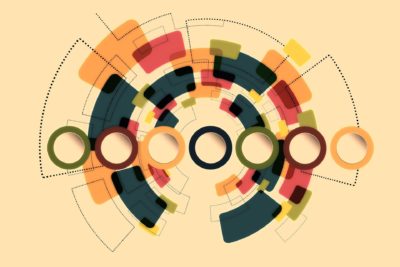SciencePOD creates eye-catching design and scientific accuracy through infographics
by Angela McQuillan, SciencePOD content creator
When science meets design, new spaces for communication are opened to us. My name is Angela McQuillan and I work as a graphic designer for SciencePOD. I am also the director of the Esther Klein Gallery, a science- and technology-focused art gallery in Philadelphia, USA.
I started my career as the manager of a cancer research laboratory at Thomas Jefferson University, also in Philadelphia. As expected, this role often involved assisting in the preparation of papers for publication in peer-reviewed journals. But the text in these papers only told part of the story, the other part was communicated through graphs, data visualisations and scientific diagrams.
It was not uncommon for my Principal Investigator (PI) to hand me a piece of paper with chicken scratch pencil drawings of molecular interactions for me to turn into illustrations. That’s when I would get to work digitally transforming these into an eye catching, print-ready graphic. This is how I got my start creating scientific diagrams for clients all over the world, and subsequently what sparked my interest in creating infographics.
Why infographics?
Infographics are a very useful tool to break down and simplify complex ideas to make them easier to understand. This is especially important in the science and technology sector as this allows information to be accessed by a much wider audience. In a fast-paced digital world, many people have short attention spans for information that is too complex or difficult to access. Scientists can use infographics as an effective data visualisation tool to give a quick overview of their research, without the formality and lengthiness of a scientific paper.
There are many ways to create an infographic but in general there are three major objectives:
1) keep the text to a minimum
2) provide eye-catching images that draw in the audience
3) illustrate the concept in the simplest way possible.
SciencePOD has a unique approach to creating infographics that ensures both a high quality visual and scientific accuracy – at SciencePOD we come together (virtually) as a team of people with different specialisations working to create the final product.
The making of infographics
When I create designs for SciencePOD, a designated science writer has already reached out to the scientist who did the original research to define their research focus. They then narrow the information down to what needs to be emphasised. The writer/concept creator will then come up with a unique way of telling the story. They typically provide ideas for imagery and concept, which I receive as a written narrative. It is then my job to bring these visions to life, creating graphics that illustrate the distilled and simplified version of the result of years of research by a team of scientists.
An example that comes to mind is an infographic I created for SciencePOD to illustrate a new biosensor that detects myobacterium tuberculosis (TB) DNA. This graphic was intended to represent a snippet of information describing this new technology, as described in an Elsevier chemistry published research paper. The challenge in this infographic was to keep it as minimal as possible, while retaining scientific accuracy. I had a bit of fun here illustrating the tuberculosis organisms as creatures with personality, complete with facial expressions and attributions of malintent. In addition, the concept creator really wanted to get the point across that this is a digital technology, so the incorporation of the circuitry and the LED number screen did the trick.
Another infographic or data visualisation project I worked on for SciencePOD aimed to illustrate the effectiveness of a novel disinfectant in killing viruses. This was produced for an innovative company called Microbide. This example stands out because, in this case, there wasn’t a specific narrative to follow. Instead, there was a chart of numerical data.
When illustrating data, there are many different types of graphs that I can choose from, but this particular information was best suited to a simple line graph with the x-axis representing time elapsed. I wanted to include imagery to make the graphic more visually compelling, but I had to be cautious to ensure this would not distract from the data. So, I decided to superimpose simple silhouette images. I selected images to represent two different virus strains that occur in chickens. The graph clearly demonstrates the effectiveness of the Microbide disinfectant at different concentrations in an eye-caching graphic that provides the right amount of information.
It is important to mention that these infographics go through various iterations. Sometimes I will come up with an illustration that is rejected or modified by the writer or the scientist, and I need to start over from scratch. This is all part of the creative process, as ideas need to be cultivated, refined and revised, in order to create the best possible infographic to accurately communicate scientific information.

